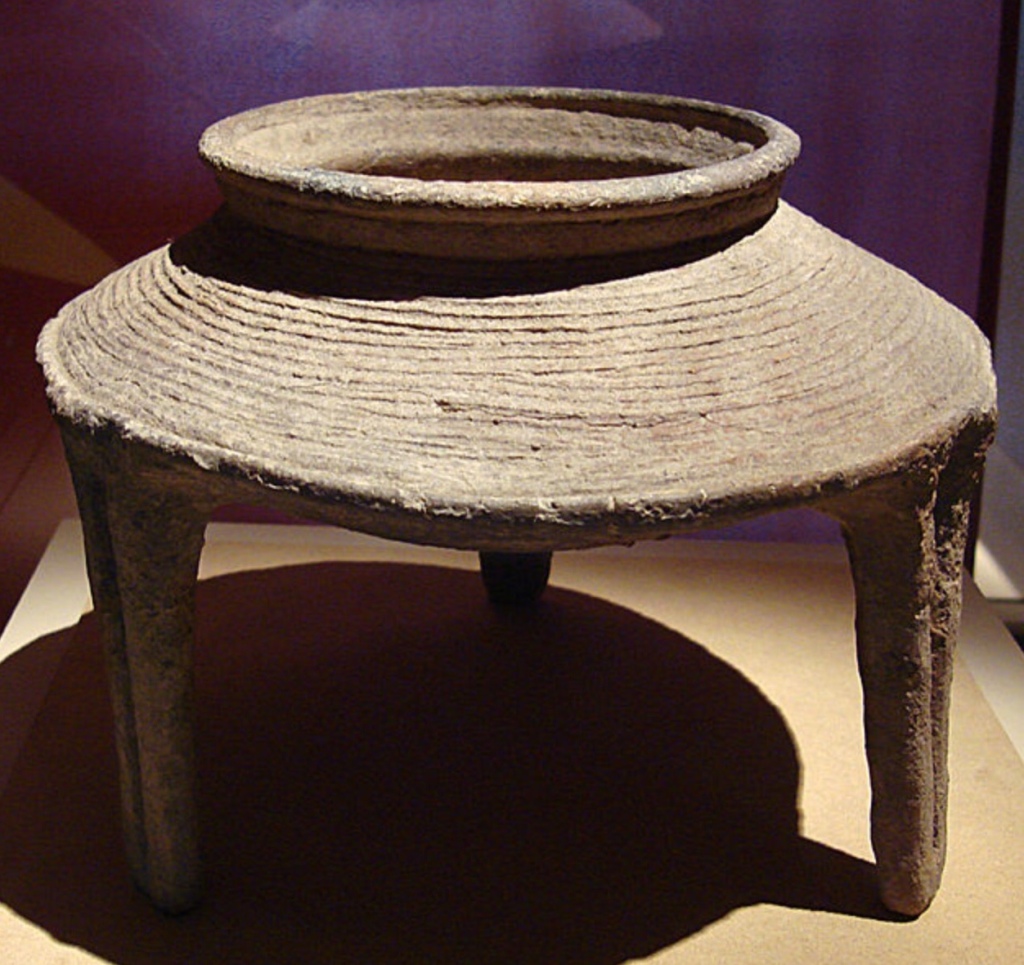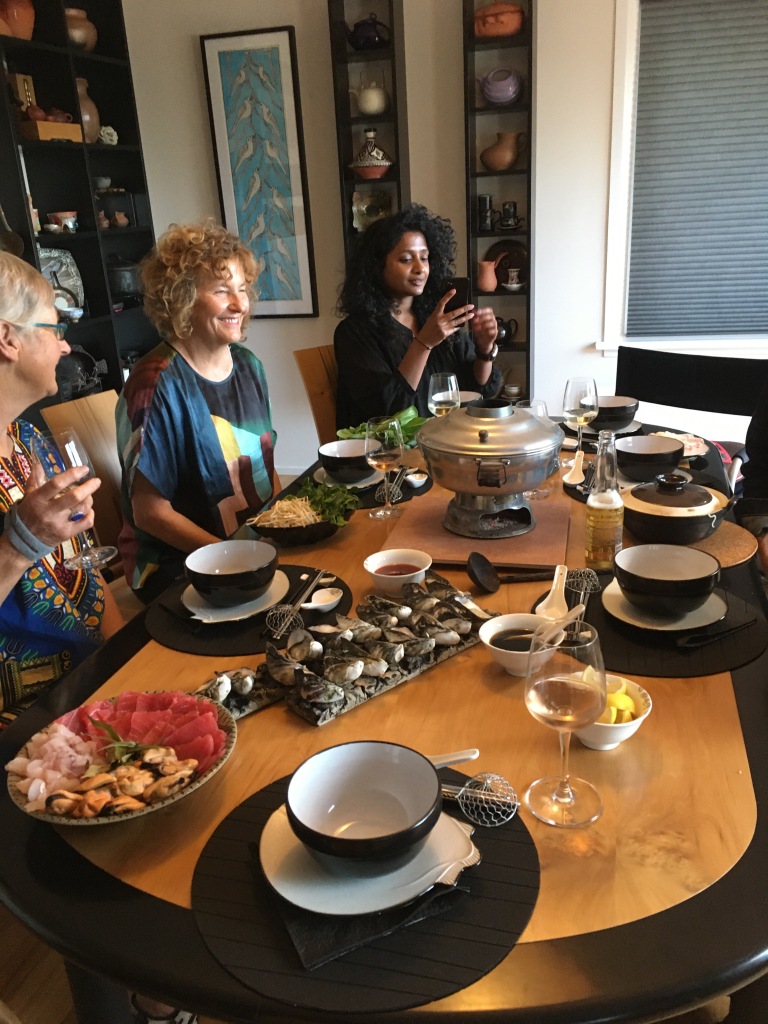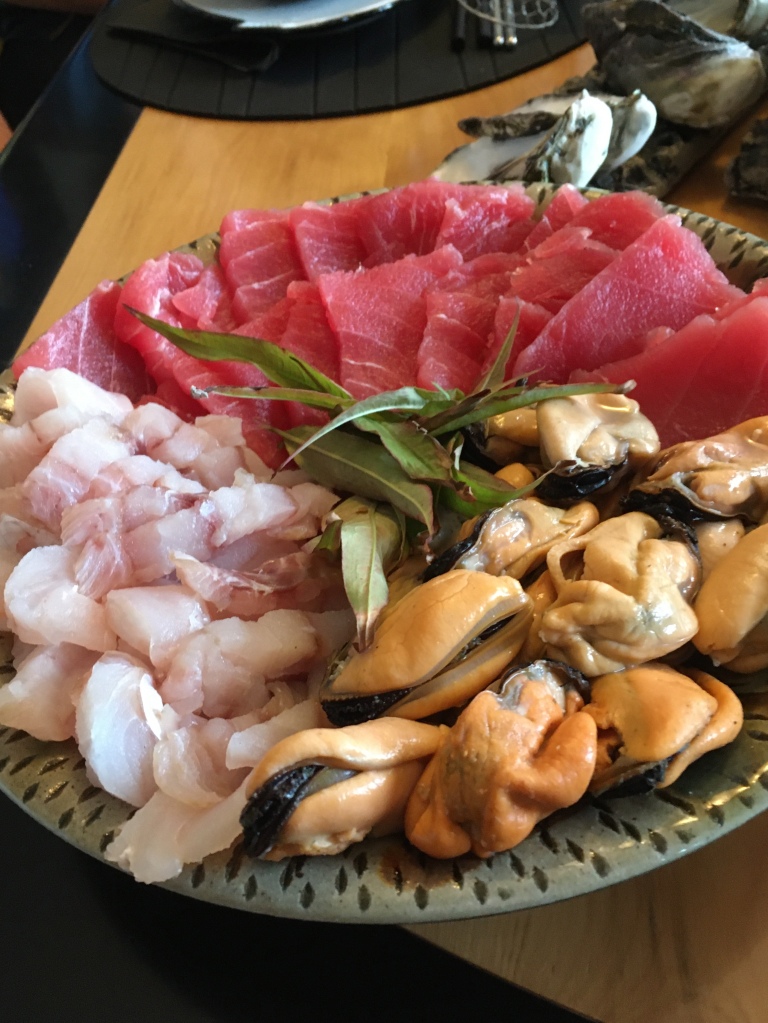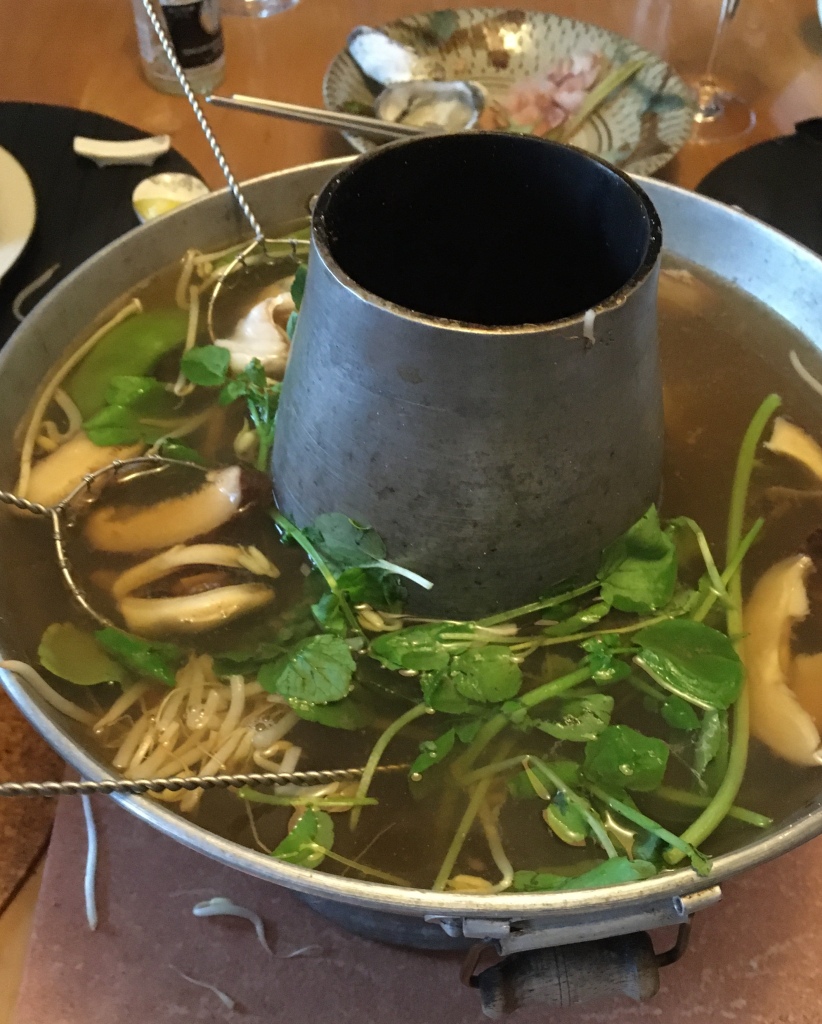Confucius, in his Book of Rites, gave us insights into ancient Chinese etiquette, protocols and customs from 3,000 years ago, that defined the element that separated savagery from civilisation as being that of fire.* Meals started to get cooked, and the most widespread dishes during this time were simple broths and stews cooked in cauldrons made of pottery over an open fire.
These early clay cooking pots would most likely have evolved into the three legged pottery ding, designed to stand over the fire, such as those made by the Yangshuo culture c. 5000-3000 BC (above left). The ding was thus originally an ordinary ceramic cooking (like the lidded vessel, above right) serving and storage vessel, dating back to the Chinese Neolithic and later, became more sophisticated by the Han dynasty (206 B.C. to 220 A.D). Whilst clay ding vessels continued to be used for cooking, the ding’s characteristic form went on to become a vessel of status when it was cast in bronze. The contemporary status of the ding has now become embedded as a contemporary design icon in the form of Shanghai’s Museum of Ancient Art (seen below from Brunyfire’s 2011 China trip) – designed by local architect Xing Tonghe and was inspired by the ancient bronze cooking pot, the Da Ke ding, that is part of the collection the museum houses.
According to Wikipedia, these early bronze dings were thought to be the earliest prototypes of the hotpot – apparently diners of the nobility during the Zhou dynasty (1046-256 BC) each had a personal bronze pot called a ran lu. These were small charcoal burning stoves with a pot above in which their food was cooked at the table similar to those below that Brunyfire encountered on the 2011 China trip.
Basically, a hotpot is a bowl of broth kept on the boil from a heat source below to which individual raw ingredients are added with chopsticks or individual wire baskets. The ingredients are left to cook in the broth for a matter of minutes till finally all that is left is the remaining broth which is served into bowls and drunk as a flavour enriched soup.
Later, the hot pot was made with copper during the Three Kingdoms period (200-280BC), and has gradually evolved into two basic forms. The more modern version comprises of a partitioned pot (of metal) in which two different flavoured broths can be kept hot at the same time like the one we encountered in Shanghai, and Chongqing, as seen below.
The hotpot broths from China’s interior and further south tend to be hot and spicy, like the variation that Brunyfire tried in Chongqing. The origins of the Chongqing hotpot (according to Wikipedia) started in the 1920’s when the cheaper cuts of meats, such as tripe, stomach, liver, intestines were cut up and cooked street side in a highly spiced broth flavoured with eye stinging amounts of chilli’s and Sichuan pepper for the poor wharf side workers.
The fiery heat of the Chongqing hotpot, provided by a combination of Sichuan pepper and chilli’s in large quantities, was originally used to disguise the cheaper cuts of meat, often of questionable freshness, and used to feed the poorest of workers, like Chongqing’s ‘bang-bang’ army. These are guys who carry anything up and down the steep slopes of Chongqing with just a bamboo shoulder pole or bangzi.
(A couple of bang-bang porters, Chongqing, 2011 of which there were 300,000 in the 1990s to no more than 10,000 in urban Chongqing today).
More traditional or older Chinese establishments often serve a fragrant, mild broth in a large brass vessel heated by burning coals in a central chimney. The broth is simmered in a deep, donut-shaped bowl surrounding the chimney like these ones on a restaurant wall in Jini Street, Chengdu.
This form of hotpot, or steamboat, owes its origins, it is said, to Mongolian horsemen from 1000 years ago, who, during the Jin dynasty, used their upturned helmets as rudimentary cooking pots to cook their beef, mutton or horse. The custom of cooking around the hotpot, or steamboat as it is also referred to, became more popular with the introduction of the table in Chinese dining habits – this meant that instead of eating individually on the floor, diners ate together at table – a much more convivial arrangement and one that embraces connectivity. (Image below from Dianxi Xiaoge video***).
Many decades ago, Brunyfire inherited the family hotpot from time spent in Malaysia and it was this that really started the interest in cooking with fire.
So as Tassie heralds the end of summer with the last of some balmy days, and heads into autumn, Brunyfire hauled out the cast aluminium hotpot and her trusty recipe book** and spent the day slicing and dicing all the ingredients to a seafood theme. The thinner the slices, the easier and quicker the food is cooked in the boiling broth, in this instance, a vegetable/seafood broth.
This way of eating is a great way to spend the evening with friends. It creates a sense of involvement and just as importantly, makes the meal stretch over a longer period of time than if the meal was served ready to eat – it also aids digestion……
……leaving room for a dessert and a cup of Chinese Puer’ah tea.
When not in use, Brunyfire’s firepot serves as a decorative table feature with native foraged flora and using an insert inside the now cooled chimney.
*Clements, Jonathan. The Emperor’s Feast: A History of China in Twelve Meals, Hodder & Stoughton, 2021.
**Hahn, Emily The Cooking of China, Time-Life Books, 1973
***Dianxi Xiaoge is a young Chinese woman who creates cooking videos about her life in rural Yunnan, China. This image has been taken from her following utube https://m.youtube.com/watch?v=ZePYb65nObs






















